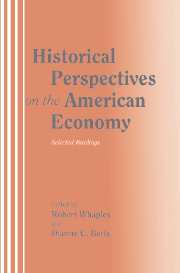Book contents
- Frontmatter
- Contents
- Acknowledgments
- Introduction to students
- Introduction to instructors
- Contributors
- I Introduction
- II Colonial and early national economy
- III Slavery and servitude
- IV The South since the Civil War
- V The rise of American industrial might
- 10 “The railroads: The first modern business enterprises, 1850s–1860s”
- 11 “Notes on the social saving controversy”
- 12 “Industrial structure and the emergence of the modern industrial corporation”
- 13 “The origins of American industrial success, 1879–1940”
- 14 “Federal policy, banking market structure, and capital mobilization in the United States, 1863–1913”
- VI Populism
- VII Women in the economy
- VIII The Great Depression
- Appendix: Basics of regression
- Glossary
- Name index
- Subject index
14 - “Federal policy, banking market structure, and capital mobilization in the United States, 1863–1913”
Published online by Cambridge University Press: 05 June 2012
- Frontmatter
- Contents
- Acknowledgments
- Introduction to students
- Introduction to instructors
- Contributors
- I Introduction
- II Colonial and early national economy
- III Slavery and servitude
- IV The South since the Civil War
- V The rise of American industrial might
- 10 “The railroads: The first modern business enterprises, 1850s–1860s”
- 11 “Notes on the social saving controversy”
- 12 “Industrial structure and the emergence of the modern industrial corporation”
- 13 “The origins of American industrial success, 1879–1940”
- 14 “Federal policy, banking market structure, and capital mobilization in the United States, 1863–1913”
- VI Populism
- VII Women in the economy
- VIII The Great Depression
- Appendix: Basics of regression
- Glossary
- Name index
- Subject index
Summary
The success with which capital funds are mobilized and transferred to industrial and related activities is widely regarded as a critical determinant of both the timing and the pace of industrialization in the modern era. Gerschenkron, for example, has suggested that institutional developments which increased this type of capital mobility played an important role in the varying degrees of industrial progress of nineteenth-century European countries. A functionally similar development, resulting from government intervention at the time of the Civil War, occurred in American banking and provided a powerful capital-supply stimulus for the United States's postbellum industrialization. This study deals with the origins of this banking development, presents an analysis of its potential effects on patterns of capital movement, and tests the hypotheses arrived at in the theoretical analysis using banking data derived primarily from the Reports of the Comptroller of the Currency.
The overall argument of the study may be summarized as follows. Two major effects of the Federal government's wartime interventions in banking, which resulted in the National Banking System, were to restrain the growth of banking over large areas of the United States for several decades, and to link the country's banks together through a reserve system that provided a formal, legally sanctioned mechanism for transferring funds between banks. The first effect left many of the country's bankers in relatively monopolistic positions where they could charge high interest rates, restrict loan output in local markets, and practice price discrimination.
- Type
- Chapter
- Information
- Historical Perspectives on the American EconomySelected Readings, pp. 482 - 508Publisher: Cambridge University PressPrint publication year: 1995



